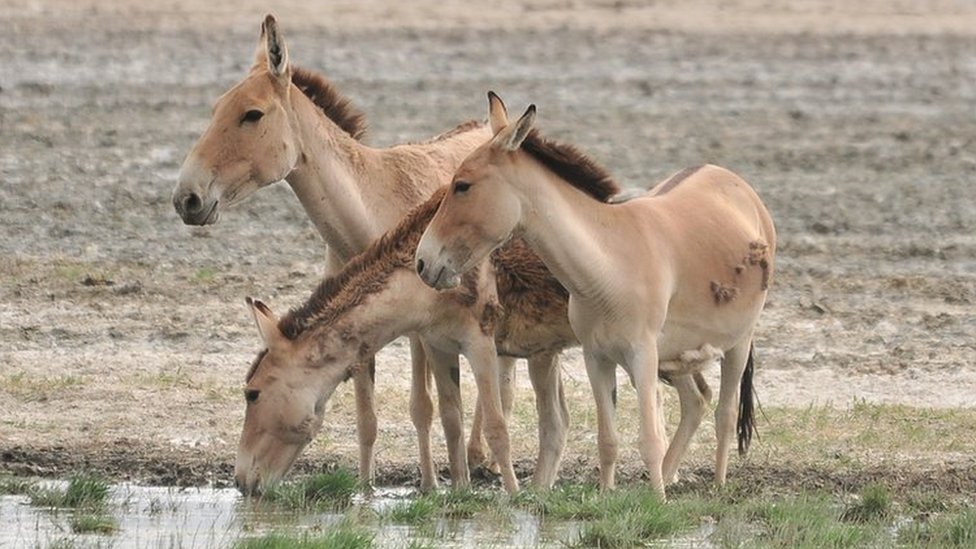INSUBCONTINENT EXCLUSIVE:
Image copyrightPetra Kaczensky/NINA"Do you see them" the radio crackled in the old Russian 4x4.The driver tried to steer away from pits and
ravines that he could barely see in the dark
The lights of another car flashed in the distance
After a prolonged silence came the answer
"No."The two drivers navigating around a national park in the dead of the night are Kazakh rangers trying to capture Asiatic wild ass, known
locally as kulans.It is a part of the operation to reintroduce these animals to the steppes of central Kazakhstan, where they disappeared a
Kulans are the zebras of Asia
They used to roam on a massive territory stretching from Syria to Mongolia but today their populations are fragmented and vulnerable
Kulans in Central Asia are in particular danger.Although they are a protected species, they are hunted for their meat and their skins in
some areas.Due to hunting and habitat conversion, they now inhabit only 3% of the territory where they formerly ranged
Their population in Kazakhstan is now estimated at about 4,000 and almost all of them are in the Altyn Emel national park in the country's
south-east.Now scientists want to relocate a group of healthy animals some 1,500 km (932 miles) away - from Altyn Emel to an area known as
Altyn Dala or the Golden steppe
"This is a huge landscape of steppe, which is approximately as big as France and almost totally devoid of human habitation," explains Dr
John Linnell, a senior researcher at the Norwegian Institute for Nature Research.Scientists hope that kulans can establish a new population
in Altyn Dala because the Altyn Emel park is becoming too crowded for them
Last year the first group of nine kulans was moved to Altyn Dala but in order to have a sustainable population there scientists need to
relocate several dozen more animals
A recent operation to capture the donkey-like animals, however, did not go according to plan
UAZ jeeps criss-crossed the area in search of kulans
The chase always takes place at night as kulans can easily escape during the daytime
Rangers use a spotlight to guide the animals into an enclosure: its beam turns into a sort of a fence, which animals are afraid to cross
On the first night, the rangers couldn't even get close to the animals
The spotlights danced across the steppe as the cars hit holes and bumps in the dark
Frustrated rangers kept shouting to each other on the radio, but all their attempts to herd the animals were unsuccessful
"We didn't have enough cars to chase," Albert Selimgereyev, a co-ordinator at the Association for Conservation of Biodiversity of Kazakhstan
"The second problem was the strong wind
It's very difficult to push kulans against the wind
Usually they never go against the wind."Image copyrightPetra Kaczensky/NINAReintroducing an animal to an area is probably the most complex
type of conservation project, says Dr Linnell.It involves an "incredible" amount of planning and detail, he says
"Like building boxes, building the capture equipment, paperwork and permissions
You have to get trucks and airplanes and more trucks to co-ordinate, you have to build a bridge because the bridge collapsed
"And all [the details] have to fall into place on the same day at the same time
And of course the wild animals have to co-operate and the weather has to co-operate and you can never count on wild animals and weather."And
when the TheIndianSubcontinent joined the mission, the weather certainly didn't co-operate
One night it was too windy; the next night it rained and spotlights became useless
On the third night, it was a bright moon, which defeated the whole point of chasing the animals at night
After seven frustrating nights of cold, wet and wind, the rangers and scientists had to give up, without having captured any kulans
In any case, the plane that was to meant to transport the animals was no longer available
It is a big setback for the reintroduction project
Yet the scientists are still determined to continue the work and come back next year
There is one big lesson from this failure, says Chris Walzer, a veterinarian from the Wildlife Conservation Society."This shows how
important it is to really conserve wildlife in wild places as restoring and reintroducing species is really inherently difficult and takes a
lot of effort and a lot of funding
So any [wildlife] place that's out there needs to be preserved as best as possible."

